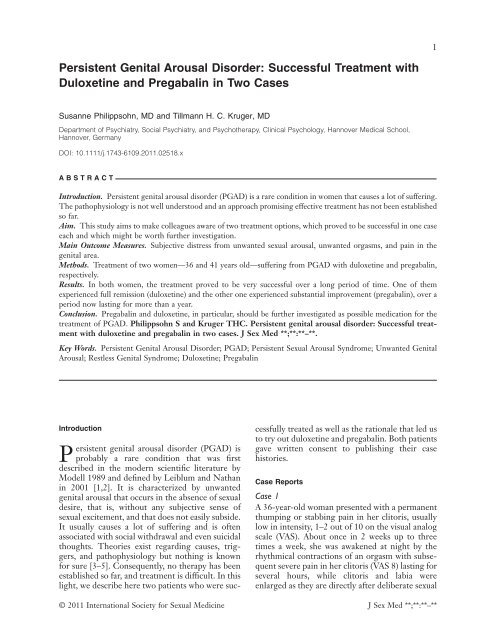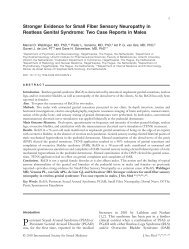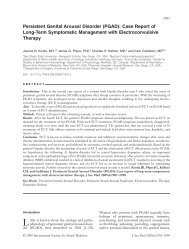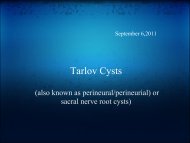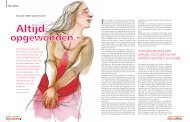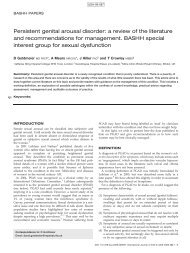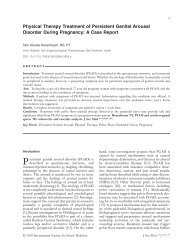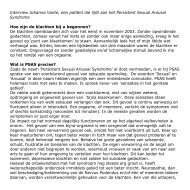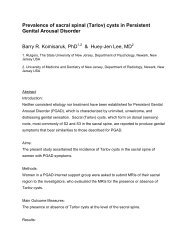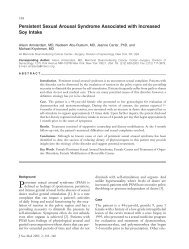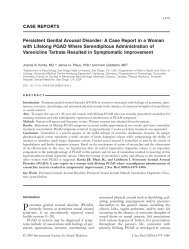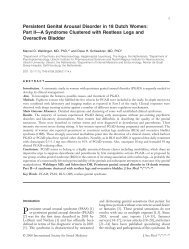Persistent Genital Arousal Disorder - (Genital) Arousal Syndrome
Persistent Genital Arousal Disorder - (Genital) Arousal Syndrome
Persistent Genital Arousal Disorder - (Genital) Arousal Syndrome
You also want an ePaper? Increase the reach of your titles
YUMPU automatically turns print PDFs into web optimized ePapers that Google loves.
1<strong>Persistent</strong> <strong>Genital</strong> <strong>Arousal</strong> <strong>Disorder</strong>: Successful Treatment withDuloxetine and Pregabalin in Two Casesjsm_2518 1..5Susanne Philippsohn, MD and Tillmann H. C. Kruger, MDDepartment of Psychiatry, Social Psychiatry, and Psychotherapy, Clinical Psychology, Hannover Medical School,Hannover, GermanyDOI: 10.1111/j.1743-6109.2011.02518.xABSTRACTIntroduction. <strong>Persistent</strong> genital arousal disorder (PGAD) is a rare condition in women that causes a lot of suffering.The pathophysiology is not well understood and an approach promising effective treatment has not been establishedso far.Aim. This study aims to make colleagues aware of two treatment options, which proved to be successful in one caseeach and which might be worth further investigation.Main Outcome Measures. Subjective distress from unwanted sexual arousal, unwanted orgasms, and pain in thegenital area.Methods. Treatment of two women—36 and 41 years old—suffering from PGAD with duloxetine and pregabalin,respectively.Results. In both women, the treatment proved to be very successful over a long period of time. One of themexperienced full remission (duloxetine) and the other one experienced substantial improvement (pregabalin), over aperiod now lasting for more than a year.Conclusion. Pregabalin and duloxetine, in particular, should be further investigated as possible medication for thetreatment of PGAD. Philippsohn S and Kruger THC. <strong>Persistent</strong> genital arousal disorder: Successful treatmentwith duloxetine and pregabalin in two cases. J Sex Med **;**:**–**.Key Words. <strong>Persistent</strong> <strong>Genital</strong> <strong>Arousal</strong> <strong>Disorder</strong>; PGAD; <strong>Persistent</strong> Sexual <strong>Arousal</strong> <strong>Syndrome</strong>; Unwanted <strong>Genital</strong><strong>Arousal</strong>; Restless <strong>Genital</strong> <strong>Syndrome</strong>; Duloxetine; PregabalinIntroduction<strong>Persistent</strong> genital arousal disorder (PGAD) isprobably a rare condition that was firstdescribed in the modern scientific literature byModell 1989 and defined by Leiblum and Nathanin 2001 [1,2]. It is characterized by unwantedgenital arousal that occurs in the absence of sexualdesire, that is, without any subjective sense ofsexual excitement, and that does not easily subside.It usually causes a lot of suffering and is oftenassociated with social withdrawal and even suicidalthoughts. Theories exist regarding causes, triggers,and pathophysiology but nothing is knownfor sure [3–5]. Consequently, no therapy has beenestablished so far, and treatment is difficult. In thislight, we describe here two patients who were successfullytreated as well as the rationale that led usto try out duloxetine and pregabalin. Both patientsgave written consent to publishing their casehistories.Case ReportsCase 1A 36-year-old woman presented with a permanentthumping or stabbing pain in her clitoris, usuallylow in intensity, 1–2 out of 10 on the visual analogscale (VAS). About once in 2 weeks up to threetimes a week, she was awakened at night by therhythmical contractions of an orgasm with subsequentsevere pain in her clitoris (VAS 8) lasting forseveral hours, while clitoris and labia wereenlarged as they are directly after deliberate sexual© 2011 International Society for Sexual Medicine J Sex Med **;**:**–**
2 Philippsohn and Krugeractivity. No subjective arousal accompanied thenightly orgasms. There were no trigger mechanismsfor the orgasms. This symptomatology hadstarted 4 years earlier with an increased urge tourinate (but without change in the frequency ofurination), followed by initially mild symptoms inthe clitoris a few months later, and finally resultingin the above-mentioned disorder. The urge tourinate led her to consult a urologist who firstdiagnosed cystitis, afterwards a bladder polyp.Treatment of these with antibiotics and surgery,respectively, did not improve the symptoms.Psychological exploration revealed no signs ofa mental illness except for emotional pressure as aconsequence of the distressing bodily symptoms.There was no history of sexual assault. Physicalexamination of pelvic and abdominal muscles,including trigger points as described by Rosenbaum,indicated heightened muscle tension in theperineal area without any indication of vaginismus[6,7]. Both legs showed varices. There wasno restless legs syndrome. Blood count, gynecologicalultrasound, and magnetic resonanceimaging of the pelvis displayed no pathologicalfindings. The patient had already tried severalanalgesics (paracetamol, ibuprofen, and metamizole)without any success. Local anesthetic gelapplied a few times to the clitoral area hadbrought only minimal relief. Other medicationswere not used.Because of the combination of urinary urgeand persistent genital arousal disorder, which wediscussed as a possible consequence of neuropathy,duloxetine was chosen for treatment, beginningwith 30 mg, titrated up to 60 mg once dailyin the morning [4]. Duloxetine is a serotonin andnorepinephrine reuptake inhibitor, which hasbeen approved for stress urinary incontinence (inEurope), pain associated with diabetic neuropathy,and depressive disorders. Within 1 week, thenightly orgasms disappeared completely, and thepermanent pain diminished considerably. After 4months of treatment, there was no longer anypain. Her sexual life was not affected, eitherbefore or during pharmacological treatment. Atthe time of writing, after some 13 months oftreatment, the effect of treatment has not fadedso far.Case 2A 41-year-old woman received amitriptyline(30 mg), a tricyclic antidepressant, because of asingle depressive episode in response to the deathof a near friend. After about 10 days of takingamitriptyline, she got a constant feeling that hertrousers had become very tight and that her privateparts were swollen. After her next sexual encounterwith her husband, she instantly developed a feelingof urinary urge and genital arousal for a few hours,which she perceived to be almost painful. Duringthe following weeks, the symptoms became moreconstant. Sexual intercourse led to temporaryrelief, as did distraction and cold showers. Masturbationand driving a car aggravated the symptoms.Stopping the intake of amitriptyline after about 2months did not change anything. Over a period ofseveral weeks, the symptoms worsened so much inintensity and constancy that the patient developedsuicidal thoughts. She tried a low dosage of theatypical antipsychotic quetiapine (25 mg) in theevening for a few weeks, which led to a reductionof the symptoms by 20%.Further psychological exploration revealed thatbodily reactions to psychological pressure were acommon pattern in her life. There was no historyof sexual assault. Gynecological examination producedno pathological results. Vaginal ultrasoundshowed pelvic varices. There was no restless legssyndrome. No further examinations were carriedout because the patient refused them.Because of the onset of symptoms during intakeof amitriptyline, the patient was not willing to tryany other antidepressant (such as duloxetine) fortreatment. Due to disturbed sleep, she then took0.5–1.0 mg clonazepam, a benzodiazepine, in theevening. This medication improved sleep moderately;however, PGAD remained unchanged.Because of the painful component of the symptomatology,it was then decided to administer pregabalin,an anticonvulsant drug approved forepilepsy, neuropathic pain, and generalized anxietydisorder, 75 mg in the morning and 100 mg in theevening. All symptoms diminished considerablywithin 2 weeks and returned in only a mild formfor a few days preceding menstruation or underconsiderable psychological pressure, both of whichthe patient said she could handle. Importantly, discontinuationof pregabalin for a period of about 2weeks brought the symptoms back in full force.Because of the patient’s known pattern of bodilyreaction to psychological pressure, she additionallystarted psychodynamic psychotherapy in orderto overcome her friend’s death and to diminishgeneral daily stress. This brought further reliefover time but no complete disappearance of theillness. As in the first case, the symptoms have notworsened again over the period of treatment,which in the meanwhile has lasted for 14 months.J Sex Med **;**:**–**
PGAD: Duloxetine and Pregabalin 3DiscussionVarious pathophysiological mechanisms have beendiscussed in recent years. Leiblum et al. prefer apsychological approach in the sense that “the tendencyto be both anxious and depressed contributesto greater worry about the existence ofspontaneous genital arousal” and so “PGA may bemaintained by anxiety” [8]. Leiblum and Chiverselaborate a circle of maintenance in which“thoughts regarding the meaning of unwantedgenital responses or morality of the individualexperiencing them may be related to the persistenceof attention to genital sensations; anxiety,associated with these thoughts may increase attentionand catastrophic thinking regarding unwantedsexual arousal” [9]. Waldinger and Schweitzerfound a large overlap of PGAD with overactivebladder and restless legs in their sample [10]. Theyconcluded from their findings that PGAD may bebecause of neuropathy, probably affecting thesensory small fibers (Ad- and the C-fibers) of thepudendal nerve [4,11]. With regard to our firstcase, we primarily hypothesized the PGAD to beof somatic etiology, such as neuropathy, becauseno mental disorder or other psychological abnormalitieswere detected. In the second case, weassumed the etiology of the disease to bemixed—somatic and psychological [1,10]. Theseconsiderations led us to administer the above mentioneddrugs, discussed more specifically in thefollowing paragraphs.In the first case, duloxetine was given. It is acombined serotonin and norepinephrine reuptakeinhibitor. One possible mechanism by whichduloxetine may have accounted for the clinicalbenefits in this case is by enhancing the tone ofdescending inhibitory pain nerve fibers in thebrain and spinal cord, which seems to be mediatedby, and dependent on, both serotonin and norepinephrine(reviewed in [12]). This inhibition can beaugmented by duloxetine as described in painfuldiabetic neuropathy, fibromyalgia, and pain associatedwith major depressive disorders [12].Because this patient did not show any signs of adepressive or anxiety disorder—one pathophysiologicalmechanism proposed by Leiblum andChivers—we assume that the major benefit asdocumented here was primarily induced by theanalgesic effects of duloxetine and not by its antidepressantor anxiolytic properties [9]. In addition,serotonergic drugs such as duloxetine exhibitinhibitory effects on sexual function most probablyvia 5-HT 2A - and 5-HT 2c -receptor agonism in thebrain [13–15]. In this case, such a mechanism mayhave accounted for the disappearance of thenightly orgasms within 1 week. In other words,increased inhibition may have accounted for a normalizationof the balance of inhibitory and excitatoryfactors, however, without evoking concretesexual side effects such as orgasmic dysfunction asseen in 33% of patients taking duloxetine [13,14].Finally, duloxetine may have had effects on thespinal cord level. Whereas the described facilitatoryneuromodulatory effect of duloxetine onpudendal motor neurons controlling urethralpressure may not have accounted for the benefithere, it is quite possible that there were inhibitoryeffects on sacral and/or thoracolumbar neuronsgenerating genital sexual arousal and orgasm[14,16,17]. The specific mechanism of actionremains speculative; however, serotonin and norepinephrinereceptors have been identified forsomatic (pudendal nerve, S2-4), sympathetic(Th11 to L2), and parasympathetic efferent nuclei(S2-S4) as well as afferent fibers of the spinal cord(reviewed in [17]), arguing for an increasinginhibitory and/or sympathetic tone.In the second case, the patient refused treatmentwith another antidepressant drug such asduloxetine. Clonazepam moderately improvedsleep but did not significantly affect PGAD.Therefore, pregabalin was administered additionally.Pregabalin is an anticonvulsant drug that hasalso received approval for neuropathic pain andgeneralized anxiety disorder. Pregabalin is ag-Aminobutyric acid (GABA) analog without anactive effect on the GABA receptor, however,binding with the auxiliary subunit (a 2 d-protein) ofvoltage gated calcium channels. It thereby functionsas a presynaptic modulator of overexcitedneurons and may reduce synaptic release ofglutamate and other neurotransmitters [18]. Inneuropathic pain, primary sensory afferentneurons are damaged, which results in hyperexcitabledorsal root ganglia, increased pain transmitterrelease in the spinal cord, and central sensitization[18]. Based on the theory that there is a neuropathicor neuronal contribution to the pathogenesisof PGAD, pregabalin can be assumed to beeffective in reducing pain in this case by modulationof specific pain neurons. This is in contrast tothe case report of Waldinger et al., where pregabalindid not show any benefit [4]. Discontinuationof pregabalin in our case brought back all symptomsimmediately, which indicates that it washighly effective here. As pregabalin is not knownto have specific antidepressant properties, it isJ Sex Med **;**:**–**
4 Philippsohn and Krugerunlikely that it acted via improvement of depressivesymptoms. Moreover, this subject showed nosign of an anxiety disorder that might also haveresponded to pregabalin treatment. Therefore, weassume that pregabalin was beneficial here primarilybecause of its analgesic effects or by some kindof modulation of overexcited neurons. Nevertheless,it is possible that the initial depressive symptomatologywas a trigger of PGAD in this woman.With regard to the timely connection betweenamitriptylin medication and PGAD onset, wecannot rule out that amitriptylin has contributedin some way to PGAD.ConclusionUnder the assumption that, in these two cases,PGAD might be a specific form of neuropathy, orneuropathy combined with psychological distress,duloxetine and pregabalin were administered.Both of these pharmacological approachesresulted in long-term reduction (pregabalin), andeven complete remission (duloxetine), of thishighly distressing condition. Because of limitedexperience and knowledge of these drugs inPGAD, different modes of action may haveaccounted for the clinical benefit including analgesic,modulatory, and sexual inhibitory effects.These observations warrant further investigationof duloxetine and pregabalin in PGAD.AcknowledgmentsTillmann H. C. Kruger would like to thank the EuropeanSociety of Sexual Medicine for receiving the grantfor Medical Research 2008.Corresponding Author: Susanne Philippsohn, MD,Department of Psychiatry, Social Psychiatry and Psychotherapy,Clinical Psychology, Hannover MedicalSchool, Carl-Neuberg-Str. 1, Hannover 30625,Germany. Tel: +49 511 532 2631; Fax: +49 511 5328407; E-mail: philippsohn.susanne@mh-hannover.deConflict of Interest: None.Statement of AuthorshipCategory 1(a) Conception and DesignSusanne Philippsohn; Tillmann H. C. Kruger(b) Acquisition of DataSusanne Philippsohn(c) Analysis and Interpretation of DataSusanne Philippsohn; Tillmann H. C. KrugerCategory 2(a) Drafting the ArticleSusanne Philippsohn; Tillmann H. C. Kruger(b) Revising It for Intellectual ContentSusanne Philippsohn; Tillmann H. C. KrugerCategory 3(a) Final Approval of the Completed ArticleSusanne Philippsohn; Tillmann H. C. KrugerReferences1 Modell JG. Repeated observations of yawning, clitoralengorgement, and orgasm associated with fluoxetine administration.J Clin Psychopharmacol 1989;9:63–5.2 Leiblum SR, Nathan SG. <strong>Persistent</strong> sexual arousal syndrome:A newly discovered pattern of female sexuality. J Sex MaritalTher 2001;27:365–80.3 Goldmeier D, Mears A, Hiller J, Crowley T. <strong>Persistent</strong> genitalarousal disorder: A review of the literature and recommendationsfor management. Int J STD AIDS 2009;20:373–7.4 Waldinger MD, de Lint GJ, Venema PL, van Gils AP,Schweitzer DH. Successful transcutaneous electrical nervestimulation in two women with restless genital syndrome: Therole of adelta- and C-nerve fibers. J Sex Med 2010;7:1190–9.5 Brotto LA, Bitzer J, Laan E, Leiblum S, Luria M. Women’ssexual desire and arousal disorders. J Sex Med 2010;7:586–614.6 Rosenbaum TY. Physical therapy evaluation of dyspareunia.In: Goldstein AT, Pukall CF, Goldstein I, eds. Female sexualpain disorders: Evaluation and management. Oxford: Wiley-Blackwell Publishing; 2009:27–31.7 Rosenbaum TY. Physical therapy treatment of persistentgenital arousal disorder during pregnancy: A case report. J SexMed 2010;7:1306–10.8 Leiblum S, Seehuus M, Goldmeier D, Brown C. Psychological,Medical, and Pharmacological Correlates of <strong>Persistent</strong><strong>Genital</strong> <strong>Arousal</strong> <strong>Disorder</strong>. J Sex Med 2007;4:1358–66.9 Leiblum SR, Chivers ML. Normal and persistent genitalarousal in women: New perspectives. J Sex Marital Ther2007;33:357–73.10 Waldinger MD, Schweitzer DH. <strong>Persistent</strong> genital arousaldisorder in 18 Dutch women: Part II. A syndrome clusteredwith restless legs and overactive bladder. J Sex Med2009;6:482–97.11 Waldinger MD, Venema PL, van Gils AP, Schweitzer DH.New insights into restless genital syndrome: Static mechanicalhyperesthesia and neuropathy of the nervus dorsalis clitoridis.J Sex Med 2009;6:2778–87.12 Bellingham GA, Peng PW. Duloxetine: A review of its pharmacologyand use in chronic pain management. Reg AnesthPain Med 2010;35:294–303.13 Clayton A, Kornstein S, Prakash A, Mallinckrodt C, WohlreichM. Changes in sexual functioning associated with duloxetine,escitalopram, and placebo in the treatment of patients withmajor depressive disorder. J Sex Med 2007;4:917–29.14 Pfaus JG. Pathways of sexual desire. J Sex Med 2009;6:1506–33.15 Korda JB, Pfaus JG, Kellner CH, Goldstein I. <strong>Persistent</strong>genital arousal disorder (PGAD): Case report of long-termsymptomatic management with electroconvulsive therapy. JSex Med 2009;6:2901–9.16 Boy S, Reitz A, Wirth B, Knapp PA, Braun PM, Haferkamp A,Schurch B. Facilitatory neuromodulative effect of duloxetineon pudendal motor neurons controlling the urethral pressure:J Sex Med **;**:**–**
PGAD: Duloxetine and Pregabalin 5A functional urodynamic study in healthy women. Eur Urol2006;50:119–25.17 Jost W, Marsalek P. Duloxetine: Mechanism of action at thelower urinary tract and Onuf ’s nucleus. Clin Auton Res2004;14:220–7.18 Bauer CS, Rahman W, Tran-van-Minh A, Lujan R, DickensonAH, Dolphin AC. The anti-allodynic alpha(2)delta ligand pregabalininhibits the trafficking of the calcium channelalpha(2)delta-1 subunit to presynaptic terminals in vivo.Biochem Soc Trans 2010;38:525–8.J Sex Med **;**:**–**


